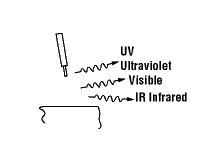Welding - Radiation and the Effects On Eyes and Skin
On this page
What types of radiation are associated with welding?
Back to topWelding arcs give off radiation over a broad range of wavelengths - from 200 nm (nanometres) to 1,400 nm (or 0.2 to 1.4 µm, micrometres). These ranges include ultraviolet (UV) radiation (200 to 400 nm), visible light (400 to 700 nm), and infrared (IR) radiation (700 to 1,400 nm).

UV-radiation is divided into three ranges - UV-A (315 to 400 nm), UV-B (280 to 315 nm) and UV-C (100 to 280 nm). UV-C and almost all UV-B are absorbed in the cornea of the eye. UV-A passes through the cornea and is absorbed in the lens of the eye.
Some UV radiation, visible light, and IR radiation can reach the retina.
What are the symptoms of "arc eye"?
Back to topCertain types of UV radiation can produce an injury to the surface and mucous membrane (conjunctiva) of the eye called "arc eye," "welders' eye," or "arc flash." These names are common names for "conjunctivitis" - an inflammation of the mucous membrane of the front of the eye. The symptoms include:
- pain - ranging from a mild feeling of pressure in the eyes to intense pain in severe instances
- tearing and reddening of the eye and membranes around the eye (bloodshot)
- a sensation of "sand in the eye"
- abnormal sensitivity to light
- inability to look at light sources (photophobia)
The amount of time required to cause these effects depends on several factors, such as the intensity of the radiation, the distance from the welding arc, the angle at which the radiation enters the eye, and the type of eye protection that the welder or bystander is using. However, exposure to just a few seconds of intense UV light can cause arc eye. These symptoms may not be felt until several hours after exposure.
Are there other possible effects on the eyes?
Back to topLong-term exposure to UV light can produce cataracts in some people. Exposure to infrared light can heat the lens of the eye and produce cataracts over the long term. The International Agency for Research on Cancer (IARC) states that there is sufficient evidence in humans that ultraviolet radiation can cause ocular melanoma (a type of eye cancer).
Visible light from welding processes is very bright and can overwhelm the ability of the iris of the eye to close sufficiently and rapidly enough to limit the brightness of the light reaching the retina. The result is that the light is temporarily blinding and fatiguing to the eye.
Note that other injuries can occur to the eye, such as damage from sparks, fumes or vapours from chemicals, particles, or flying objects (e.g., debris, slag, etc.). Please see the OSH Answers on Welding - Fumes and Gases and Welding - Personal Protective Equipment and Clothing for more information.
What are the skin hazards associated with welding and radiation?
Back to topWelding arcs and flames emit intense visible, ultraviolet, and infrared radiation. IARC has classified ultraviolet radiation (including radiation from sunlight, tanning beds, and welding) as causing cancer.
- UV radiation in a welding arc will burn unprotected skin, just like UV radiation in sunlight. This hazard applies to direct exposure to UV radiation as well as radiation reflected from metal surfaces, walls, and ceilings. Surface finishes and certain paint colours can reduce the amount of UV radiation that is reflected.
- Long-term exposure to UV radiation can cause skin cancer.
- Infrared radiation and visible light normally have very little effect on the skin.
- Fact sheet last revised: 2025-10-15

